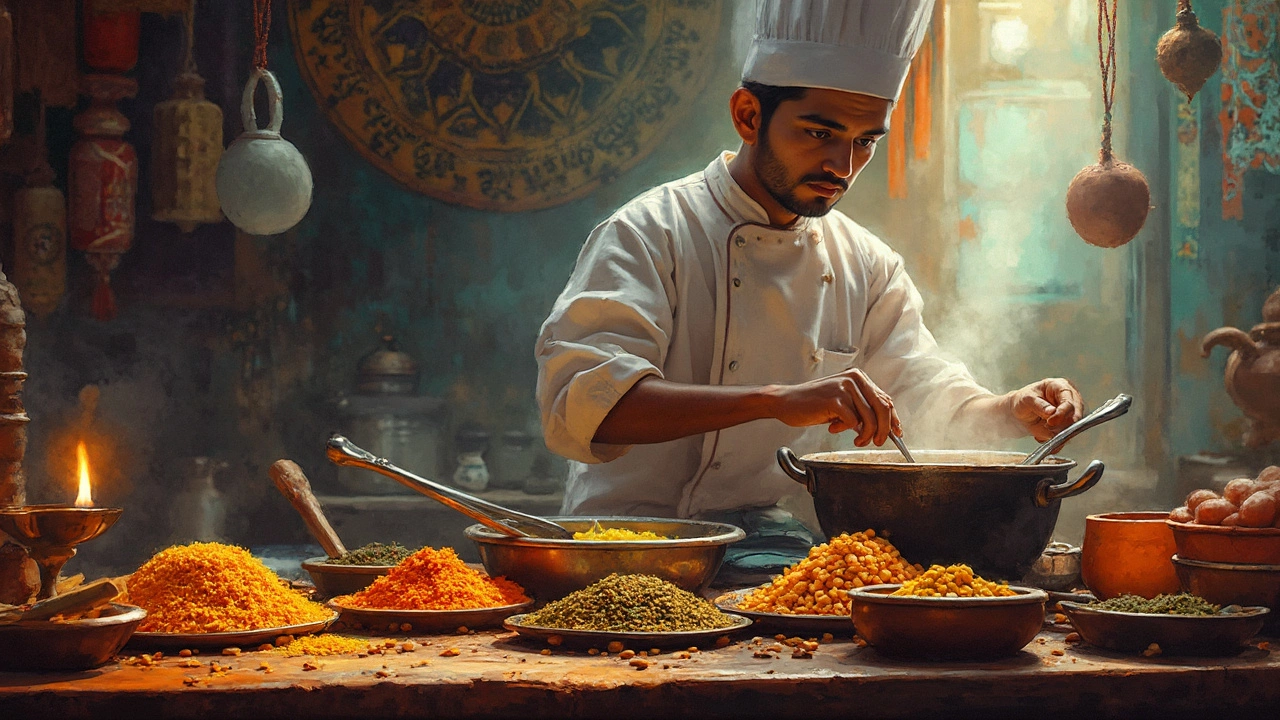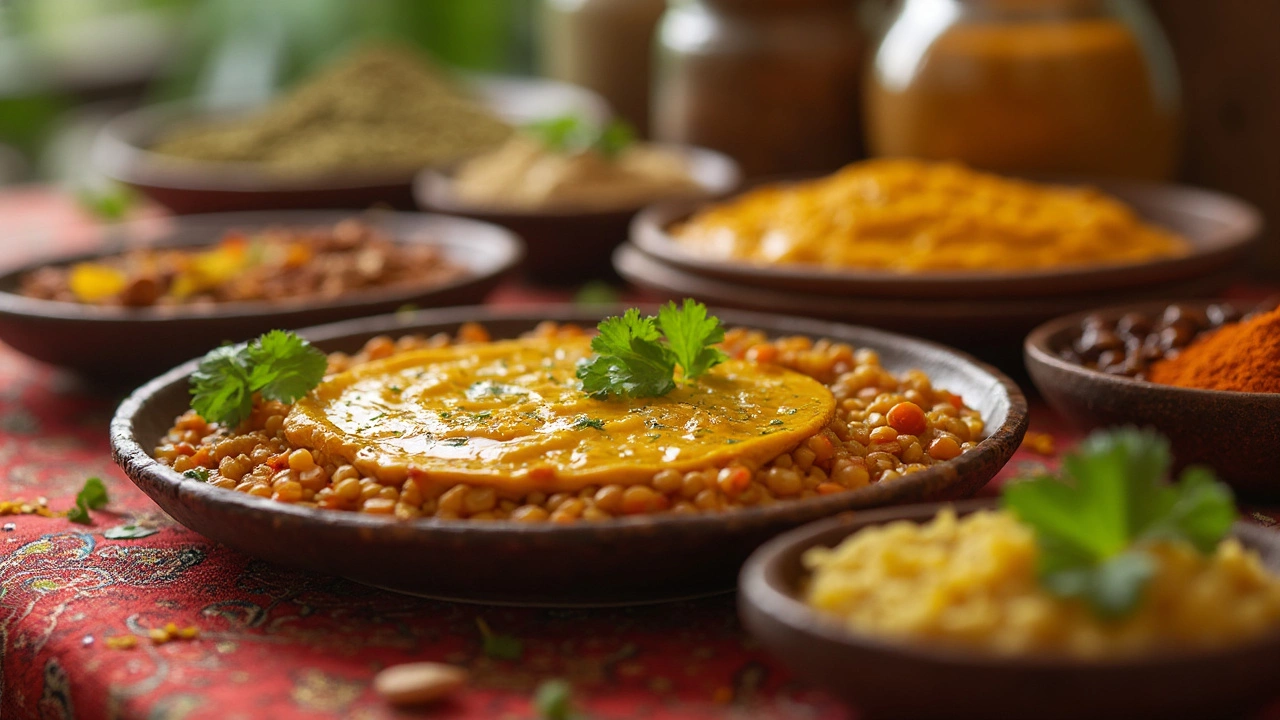Enhance Dal's Taste with These Simple Hacks
 Feb, 12 2025
Feb, 12 2025
Ever wonder why a bowl of dal at your favorite restaurant tastes richer than the one you make at home? It's not magic—it's all about how you enhance the flavors. Dal, that simple yet comforting staple, doesn’t have to be bland. Let's delve into ways you can boost its flavor.
First off, the type of lentil or pulse you choose sets the stage. Each variety, from toor to moong, brings a unique texture and flavor. Want a creamier dal? Try red lentils as they melt into a wonderful mush.
Then there's the spice mix. Even if you stick with basic spices, the trick lies in the order and method of cooking them. Why not toast your spices? This simple step can elevate each mouthful with a warm, aromatic kick.
- Understanding Dal Varieties
- The Magic of Spices
- Cooking Techniques that Matter
- Additional Flavor Enhancers
Understanding Dal Varieties
When it comes to dal, variety is the name of the game. Knowing the different types of lentils can really step up your cooking game and unlock new flavors. Each type has its own unique taste, texture, and even cooking time.
Common Types of Dal
Here's the lowdown on some popular varieties:
- Toor Dal (Split Pigeon Peas): This is the most common type, especially in Indian households. Known for its mild, nutty taste, toor dal is a staple in sambar and other South Asian dishes.
- Moong Dal (Yellow Lentils): Quick-cooking and versatile, moong dal is light and easy on the stomach. It's perfect for a quick meal.
- Masoor Dal (Red Lentils): These cook down beautifully to create a creamy texture. They're widely used in soups and are quite adaptable to various spices.
- Chana Dal (Split Chickpeas): With a slightly sweet and nutty flavor, chana dal holds its shape well, making it great for salads and curries alike.
Choosing the right dal for your recipe is crucial. Want something rich and hearty? Go for chana or toor. A light bite? Moong's your best bet.
Cooking Tips
Each type of dal has a different cooking time, so if you're mixing them, consider using a pressure cooker. This can save you from the hassle of unevenly cooked lentils!
Nutrition Facts
You might be wondering about the nutrition game. Here’s a quick table to help you out:
| Type of Dal | Protein (per 100g) | Cooking Time |
|---|---|---|
| Toor Dal | 22g | 45 mins |
| Moong Dal | 24g | 30 mins |
| Masoor Dal | 25g | 25 mins |
| Chana Dal | 19g | 50 mins |
Armed with this knowledge, you're all set to turn your everyday dal recipe into a flavorful masterpiece. Remember, the choice of dal can make or break your dish, so choose wisely!
The Magic of Spices
Spices are the heart and soul of dal, turning a basic stew into a delightful dance of flavors. Let's unravel some secrets behind these tiny powerhouses.
Understanding Spice Roles
Ever notice how dal recipes call for a dozen spices but never explain why? Each spice has a role. Cumin and mustard seeds often form the base; they add a nutty aroma when sautéed. Turmeric isn't just about color—it imparts an earthy taste and boasts anti-inflammatory properties. And don't forget the heat! While red chili powder brings a fiery kick, using fresh green chilies can add a layer of freshness.
Timing Is Key
Simply adding spices isn't enough; timing them is crucial. Typically, whole spices like cumin and asafoetida go in early, right into the hot oil, releasing essential oils that pack a flavor punch. Ground spices follow, allowing them to blend seamlessly without burning.
Toasting Spices
Toasting is a game-changer. Before adding water to your dal, heat your spices in a dry pan until they crackle and pop. It intensifies their natural oils and enhances aroma, making your dal truly unforgettable.
Creating Your Own Blend
Think outside the recipe box and play around. Try adding garam masala or a pinch of amchur powder for tanginess right at the end of cooking. A homemade spice blend is simple. Toast a mix of your favorites—coriander, cumin, fennel—and grind them fine. Store in an airtight jar for sprinkling anytime.
These little tricks don’t just enhance the taste of your dal; they add your personal touch to the dish. So go ahead, keep experimenting, and watch your bowl of dal transform from usual to extraordinary.

Cooking Techniques that Matter
While ingredients are crucial, how you cook your dal can make or break the taste. Let’s talk about some essential cooking techniques that can enhance your dal recipe.
Soaking Lentils
Start by soaking the lentils before cooking. This step helps in reducing cooking time and makes them easier to digest. Typically, soaking for about 30 minutes is sufficient, but this can vary based on the type of lentil you use.
Temper Your Spices
Once your lentils are ready, focus on tempering, a traditional technique involving cooking spices in oil. Heat some oil or ghee in a pan, then add spices like cumin, mustard seeds, or asafoetida. This process, known as tempering, releases essential oils in spices, intensifying their aroma and flavor, making your flavorful dal taste heavenly.
Simmer for Perfect Consistency
After adding your tempered spices and lentils to a pot with water, how long you let it simmer is key. A gentle simmer allows flavors to meld beautifully. The trick is to cook until the lentils fully break down, giving you a creamy texture. Usually, 20 to 30 minutes should get you there.
Timing the Salt
Adding salt seems simple, right? But when you add it can change everything. Early in the cooking process? Nope. Add it once your lentils are almost cooked. This avoids toughening and helps your enhance dal taste.
| Lentil Type | Soaking Time | Cooking Time |
|---|---|---|
| Moong Dal | 30 minutes | 20-25 minutes |
| Toor Dal | 1 hour | 25-30 minutes |
| Red Lentils | 20 minutes | 15-20 minutes |
Experiment with these techniques to master the art of cooking dal. Remember, practice makes perfect, and soon you'll be crafting dal as delicious as any restaurant could offer.
Additional Flavor Enhancers
Once you've got the basics down, you can start experimenting with a few other ingredients to give your dal that extra punch. These enhancements don't require fancy skills—just a bit of curiosity and a willingness to try something new!
Herbs and Greens
Add fresh herbs like coriander or parsley for a burst of freshness. A handful of spinach or kale stirred in at the end can boost both flavor and nutrition. It's a simple way to make your dal recipe more colorful and interesting.
Acidic Twists
A little acidity can work wonders. Squeeze some lemon or lime juice just before serving. You’ll be surprised by how much this brightens and balances the flavors.
Sweet and Smoky
Ever tried adding a touch of sweetness? A pinch of sugar or jaggery rounds off the flavors nicely. And for those who love a smoky aroma, try a little smoked paprika or char a piece of dried red chili and toss it in.
Dairy Delights
Swirl in a spoonful of yogurt or cream before serving. It adds a luxurious texture without much effort—perfect for those who like their dal rich and creamy.
Nutty Additions
Crispy fried onions, garlic slivers, or roasted cashews can add a delightful crunch and flavor depth. Sprinkle them as a garnish right before digging in for the best effect.
Enhancing dal taste doesn’t have to be complicated. With these simple yet effective tweaks, you can elevate your everyday dal to something extraordinary, making mealtime exciting without any hassle.
